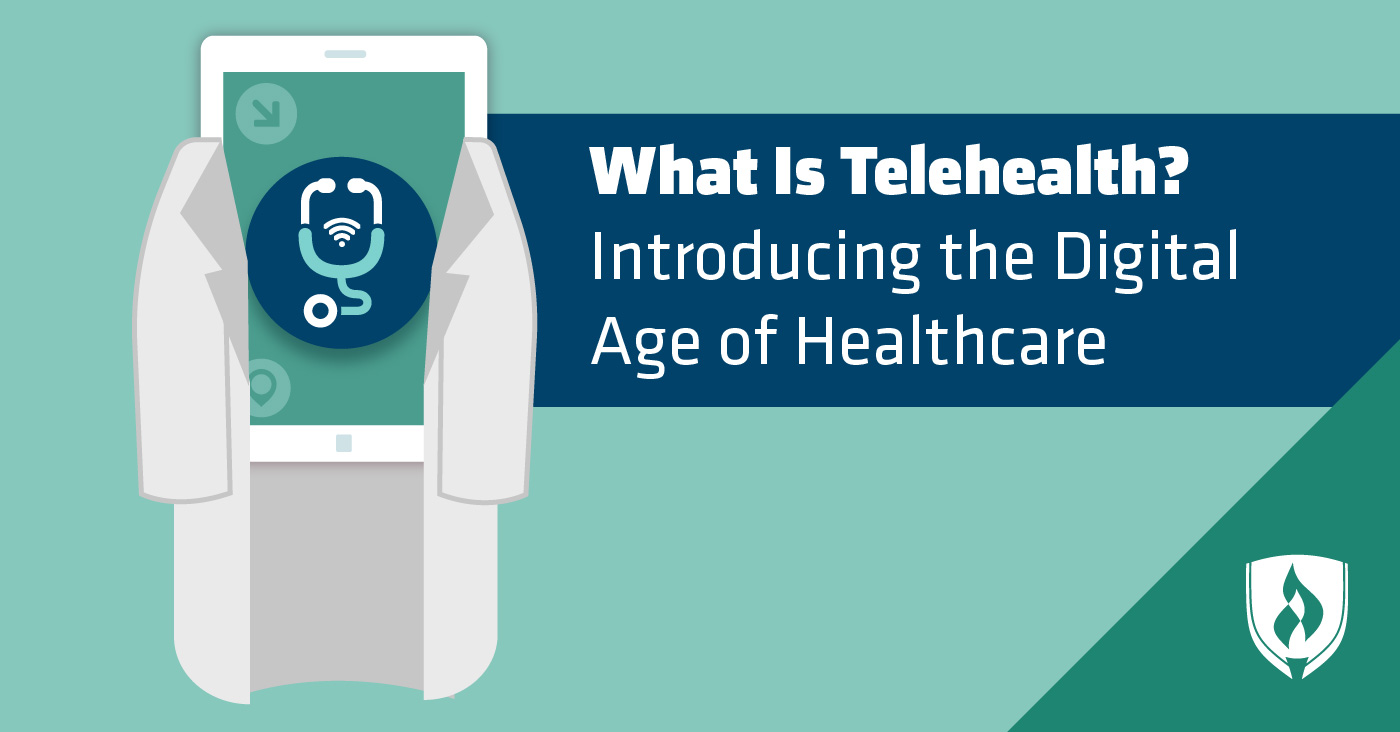
Healthcare has undergone plenty of changes through time, adapting with each medical and technological advancement. Long gone are the grisly days of ether, chloroform, leeches and bloodletting. Today’s medicine continues to advance as we look to electronic health records, AI and wearable devices for our health needs.
Modern medicine continues to evolve into a safer and more convenient practice with technology at the helm. Just like other industries, healthcare has entered into the digital economy, taking advantage of advancements in technology to better serve their patients and run their facilities. This is called telehealth—and it is changing healthcare as we know it.
You may be wondering—what is telehealth? And what does it mean for healthcare?
We spoke with a few healthcare experts to learn more about how telehealth is shaking up the healthcare industry for patients and professionals alike. Keep reading to see what they reveal about its impact and the future of healthcare. Additionally, explore Critical Factors that Impact Patient Experience to gain insights into the broader context of healthcare transformation.
What is telehealth, exactly?
Telehealth is defined as the use of electronic information and telecommunications technology to support long-distance clinical healthcare, according to the U.S. Department of Health and Human Services.
Some examples include video conferencing, sharing images online, streaming media and wireless communication. Technologies such as these can be used to support not only clinical healthcare, but also patient education, public health and health administration.
You may have already embraced telehealth without realizing it. Telehealth encompasses more than you may have thought. Below are a few examples of how telehealth is used:
- Patient portals
- Virtual appointments
- Wearable devices allowing for remote monitoring
- Tracking health information in a personal health app
Telehealth supports and promotes healthcare from a distance, connecting patients with healthcare providers and the resources they need to control their own health. It also supports continuity of care and allows healthcare professionals to better serve their patients.
How does telehealth benefit patients and providers?
Telehealth holds the potential to truly shake up healthcare as we know it—and its effects are already underway in some areas of medicine, such as psychiatry.
“Telehealth is becoming more popular and widespread in providing mental health services,” says Bina Bird, MA, licensed marriage and family therapist. “As a licensed therapist, I'm able to meet with clients remotely using Skype-like HIPAA-compliant platforms.”
She explains that virtual appointments are sometimes preferred by busy patients. This can also be a great benefit for patients with conditions, such as anxiety disorders, that can make a trip into the office difficult. Virtual appointments can better serve patients in these scenarios.
Bird also believes that telehealth is driving change in healthcare by making it more accessible to patients. Telehealth dismantles barriers that may keep patients from getting help. Whether that’s geographic limitations, time, financial means or simply not having childcare, there are plenty of barriers that keep people from receiving treatment. Telehealth could change that—and it could be especially impactful for certain populations.
“Telemedicine, especially telepathology, will increase access to care, especially for poor and rural populations. It will increase the quality of care and decrease the cost,” says Dr. Kate Tulenko, pediatrician and CEO of Corvus Health.
Bird also points out that more people receiving help at the outpatient level can prevent conditions from escalating and needing inpatient care, saving time and money for all involved.
“This helps everyone both from a safety perspective as well as from an emotional and financial perspective. Outpatient care is much more cost effective and less restrictive for clients than a 24/7 inpatient facility,” she explains.
Telehealth benefits not just patients, but also healthcare organizations. For example, telehealth can increase the productivity of providers. Appointment cycle times are faster with telemedicine, as turnover time between patients is minimal. Telemedicine can be used for low-complexity patients, and as a result, doctors can spend more time with patients who have complex needs, explains Neil Baum, MD and medical consultant at Vanguard Communications.
Additionally, telemedicine can make it more feasible for healthcare professionals to better serve patients outside of normal office hours. Telemedicine can allow doctors to conduct appointments without nursing and clinical staff, which both reduces overhead costs and allows for after-hours appointments. Telemedicine can also reduce the amount of no-shows, points out Baum.
With the benefits of telehealth being so numerous for patients and providers, don’t expect it to go away anytime soon. It’s no passing fad—in fact, it’s altering the healthcare industry for good.
How will telehealth change the healthcare industry?
Telehealth is just starting to chip away at our long-held notions of how healthcare is provided. But how will telehealth influence healthcare over time?
“Telemedicine is going to be a game changer in 2018 and beyond. No longer can patients take four to six hours to leave their work and go to a doctor’s office. With technology being so readily available and encrypted for safety and privacy, patients are going to be requesting to communicate with their physicians using telemedicine,” says Baum.
With patients growing more comfortable with technology and becoming accustomed to the convenience it affords, telehealth will become an extension of traditional healthcare facilities.
“Technology will completely change healthcare as we know it. Within five years, more care will be via telehealth than traditional face-to-face care,” predicts Aideen Turner PT, certified MDT and CEO of Virtual Physical Therapists.
"Technology will completely change healthcare as we know it."
With more and more insurance carriers covering telehealth services, he may be right. But telehealth is still an emerging practice with a few murky areas. For example, the legal definition of telemedicine still has many variations. In some states, any electronic communications not involving video conferencing are not considered telemedicine, explains Ron Harman King, CEO of Vanguard Communications.
And telehealth still encounters variations in regulatory bodies—some states rely on statutes, others on regulatory boards, which may have differing or even contradicting rules and guidelines. Still, telehealth has made great strides recently.
“The legality of practicing medicine across state lines has undergone tremendous reform in just four years,” says King.
In 2013, the Federation of State Medical Boards formed the Interstate Medical Licensure Compact. This allows qualified doctors to perform licensed services in all states participating in the compact. Currently, the compact is comprised of 21 states and the District of Columbia. That means a qualified doctor in any of the 22 jurisdictions is legally allowed to practice telemedicine with a patient in any of the 21 other jurisdictions, explains King.
This could open the doors of telemedicine over greater distances, connecting patients with specialists far and wide, especially for those in remote areas. One could also argue that patients are becoming more comfortable with technology and using it in all areas of their lives.
“Today's generation is so comfortable with the technology that I anticipate the mental health field moving more in the direction of telehealth. It gives people more choices in which provider they can choose as they aren't limited by geographic area, including ability to see providers internationally,” says Bird.
Greater selection of providers is one way telehealth will influence healthcare in the long run. This, along with a patient’s greater sense of ownership, will define the future of healthcare moving forward.
“The individual will take a central role in their own healthcare, because health savings accounts will become the norm, resulting in an increased interest in the cost of procedures. Medicine will move more from ‘evidenced-based’ to ‘precision,’ resulting in less need for costly procedures and unnecessary surgeries. Medical records will be central and allow all to access. Patient empowerment will be central,” says Turner.
Because of telehealth’s influence, themes of patient empowerment, access to services and low costs will define healthcare moving forward.
The future of healthcare
So, exactly what is telehealth?
It’s what patients and providers need to exchange vital health information. It’s the industry’s newest embrace of increased accessibility. It’s how patients are taking control of their own health. And it’s shaking up the industry for the foreseeable future.
The digital economy forever changed the American landscape, with healthcare being no exception. Change is just getting underway in this industry, and it’s not stopping any time soon.
Be sure to stay up to date with the changing times. Learn more about resources for keeping a pulse on the hot-button topics in the industry in our article, “Keeping Up With Technology in Healthcare: 10 HIT Blogs Worth Following.”
Related Articles:




